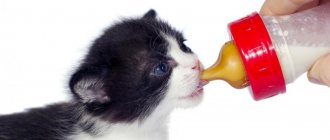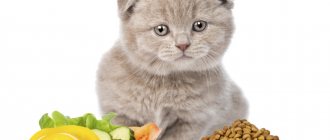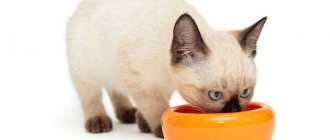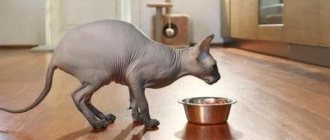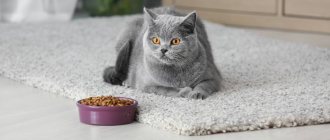Kittens at the age of 4 months begin to grow faster, muscle mass increases, the skeleton strengthens and develops, teeth change - serious changes in the body begin. As a result, a problem arises - what to feed a kitten at 4 months, since the subsequent development of the baby directly depends on this. It is necessary to create a balanced diet that contains the most important substances, microelements and all vitamins.
At this age, the little fluffy ball is actively interested in its environment and often plays with different objects. Therefore, the baby needs a lot of energy for these actions. Restructuring in the body and active growth also consumes many resources. The kitten's body can only receive them through food. The health and further development of the baby directly depends on its composition and components.
Features of kitten development at 3 months
At the age of 3 months, the kitten is in the stage of active growth, in addition, he is constantly improving his motor skills. Few people pay attention to this, but at the age of 3 months, kittens learn to go to bed, and not fall and fall asleep wherever they are.
During this same period, the kitten’s immune protection, which it received from its mother’s milk, weakens, so soon after moving to a new home, the baby needs to be vaccinated.
The developmental characteristics of a 3-month-old kitten require a balanced diet that compensates for all the body’s needs.
Remember that by the age of 4–5 months, the kitten will begin to change its milk teeth, which threatens a deficiency of microelements. Until this period, your main task is to ensure that your pet’s digestive tract adapts to digesting new food.
Before vaccination, preventive measures are taken to eliminate worms. During this period, the kitten may experience diarrhea or other disorders of the digestive tract that are not related to the type of food. To eliminate risks as much as possible, during the anthelmintic period, the kitten is placed on a diet of nutritious but easily digestible foods.
Ready-made feed
The composition of industrial feeds is already balanced. This diet is enriched with vitamin and mineral supplements necessary for the development of the kitten. There are dry and wet food. When feeding, it is better to give preference to one type of food. If you still decide to use both dry and wet food, then separate them and feed them at different meals.
Advantages of ready-made feed:
- Convenience. Such food saves time that would have to be spent on cooking.
- The feed is already balanced.
- When eating dry food, the kitten actively works with its jaws, which puts the necessary load on the entire oral apparatus. This stimulation promotes proper development of the jaw muscles and bones.
- Among the ready-made foods there is a large selection of lines according to the tastes and physiological state of the pet.
Disadvantages of ready-made feeds:
- High quality feed has a high cost.
- It is difficult to choose food among a large number of different brands.
- Dependence on economy-class flavor enhancers is developing.
Rules for feeding a 3 month old kitten dry food:
- Feed should be given in accordance with the norm indicated on the package.
- The food must correspond to the type of animal, its age and physiological condition.
- It is better to feed the same brand and line of food.
- When feeding dry food, clean water should be nearby.
- Food should not sit in a bowl; such food becomes of poor quality.
Acana
Canadian-made food belongs to the super-premium class. The composition is good, does not contain cereals. Fresh (8%) and raw (8%) meat, fresh whole eggs (8%), as well as dehydrated poultry (8%), and offal are used as a source of protein. The total amount of protein products is 35%. There are useful ingredients such as: apple, pear, cranberry, brown algae, carrots, pumpkin and others.
Only dry food with fish, lamb and chicken flavors is available for sale.
The feeding rate for kittens 5-20 weeks is 60 grams per kg of weight.
Royal Canin
Premium food. The protein content in wet food is 10-12%, and in dry food 36%. The protein in this food is mainly vegetable. Excess amount of carbohydrates. There are also corn flour, dry beet pulp, and soybean components.
This brand of food contains mainly poultry meat. Royal Canin brand food is presented in the form of canned pates, wet and dry ready-made food.
For babies aged three months, you should choose Royal Canin MOTHER&BABYCAT food - this food is perfect for feeding kittens from 1 to 4 months. For a four-month-old kitten, Royal Canin Kitten food is suitable. This food can be fed to kittens from 4 to 12 months.
During the day, the baby will need 50-65 g and 55-70 g, respectively.
Bosch Sanabelle Kitten
This food belongs to the same class as Royal Canin. The composition contains all the necessary components. Fresh poultry meat – 25%, fresh liver – 5%. The composition is enriched with fiber, eggs, animal fats, calcium supplements and brewer's yeast. Also in the list of ingredients there are those that can cause allergies - these are maize and cellulose.
Kittens can eat this food for up to a year, and it is also suitable for pregnant and lactating cats. You can choose either dry food or wet food.
The feeding rate is 55-60 g and 60-65 g, respectively.
What to feed a kitten: homemade food, dry or wet food
Many owners face a difficult choice when they try to decide what to feed their pet - homemade food or industrial food. Both types of feeding have pros and cons. In addition, a commercial diet involves dry food, wet food, or alternating the two.
The natural diet of a 3 month old kitten consists of:
- Whole milk.
- Boiled meat, peeled from skin and bones.
- Raw minced meat, previously frozen for 3-4 days.
- Homemade fermented milk products.
- Chicken egg yolk or quail eggs.
- Low-fat broths.
- A small amount of vegetables.
- Vitamin supplements.
- Greenery.
Benefits of homemade food:
- You can control the freshness and quality of the products.
- Natural food is more natural for cats, which is why most industrial food manufacturers advertise their products as being as close as possible to natural products.
- With the help of a natural diet, you can regulate the functioning of the kitten’s gastrointestinal tract.
- Any vitamins and supplements can be added to a natural diet.
Water in the diet of a three-month kitten
Regardless of age, water plays a vital role in your pet's diet. At the age of 3 months, kittens are reluctant to drink water, or rather, they become accustomed to this procedure. Immediately after moving to a new home, the kitten does not drink water well because it is not used to it. Being close to its mother, the kitten received enough water from milk.
If you are planning to transfer your pet to industrial feeding, make sure that he knows how and willingly drinks water. Almost all commercial food contains preservatives that absorb water from the pet's gastrointestinal tract. This feature of industrial feeding can lead to the development of dehydration in a kitten within a few hours, if suddenly switched to dry food.
Consequences of poor nutrition
In the wrong nutritional conditions for a kitten, various diseases and problems are hidden. This can lead to terrible diseases:
- Urolithiasis disease. Typically, this disease is chronic in nature and is characterized by the presence of sand and stones in the organs of the urinary system.
- Diabetes. It can develop both as a result of genetics and in the process of life, when there is a decrease in immunity.
- Poisoning. The same food from the store that we eat can have a detrimental effect on the health of our pet. Toxic products can lead to serious consequences of poisoning.
- Avitaminosis. Kittens need a balance of vitamins, and when this balance is not seen, failures begin in certain organs: muscles do not develop, the immune system decreases.
- Allergy. Many products that have a very specific composition can cause allergies in your pet.
- Shedding. It is believed that it comes with the onset of spring for every pet, but shedding also directly depends on improper feeding, which lacks necessary minerals and vitamins.
Monitor the kitten from the very first days, and feed the kitten only the right foods. You should also not avoid visiting a doctor.
If you notice your pet is feeling unwell, take him to the doctor immediately
Feeding mode
Usually, at the age of 3-4 months, kittens move to a new home. Separation from the mother and usual habitat leads to the development of stress. It is impossible to avoid stress, however, you need to make every effort to ensure that the change of environment does not harm the kitten’s health.
In the first days of life in a new home, it is not recommended to change the feeding regimen and type of food. Before moving to a new home, ask the breeder what he supplements the kittens with and how often the kittens receive food. Stock up on the necessary supplies for a few weeks until you are sure that the kitten is accustomed to its new home. Maintain your usual schedule, do not force your baby's attention, feed him on demand and make sure he empties his bowels and bladder.
Important! Against the backdrop of severe stress, the kitten will develop a loss of strength, which can lead to mild apathy and drowsiness. To smooth out the adaptation as much as possible, arrange resting places for the kitten in advance.
After a few weeks, as your pet adapts to its new home, you can develop a comfortable feeding routine. According to generally accepted rules, at the age of three months, kittens are fed 4–6 times, depending on individual characteristics. If the baby is stunted or is not gaining weight well, he is fed in small portions, but more often. At normal growth rates, the feeding frequency is reduced to 4 times. If the baby looks hungry between meals, he is offered a snack in the form of cottage cheese or milk.
A stable feeding regime allows you not only to teach your pet discipline, but also to monitor its health. The frequency of bowel movements directly depends on the feeding regimen. You will be able to notice constipation or other problems with the digestive tract in time if your pet does not go to the toilet on schedule.
A harmonious menu for cheerful gourmets
According to the recommendations of breeders and veterinarians, a representative of the cat family needs 40 grams of meat and 170-230 grams of other food per day. If we are talking about wet ready-made food, then each manufacturer indicates on the pack a certain daily amount of this particular product.
Traditionally, feeding during the day involves 4-5 meals a day . What might a kitten's daily diet include? For example, a morning dish can consist of raw yolk and cottage cheese, for lunch you can give meat and vegetables, for an afternoon snack you can choose kefir or fermented baked milk, and for dinner you can prepare porridge with bran. Of course, you shouldn’t write out the menu for the year, but planning for a week in advance is quite justified.
A furry baby at such a tender age cannot eat too solid food. He should not be given bones, bread or potatoes.
Otherwise, your little tummy will bloat. In addition, there is a list of strictly prohibited foods that cannot be offered to a kitten at 4 months.
© shutterstock




